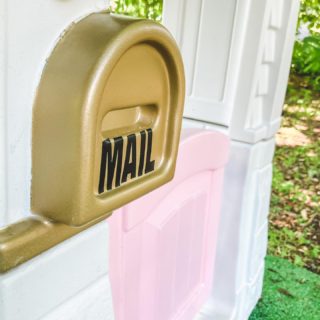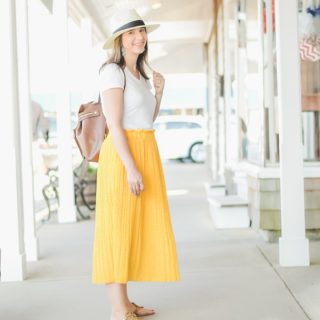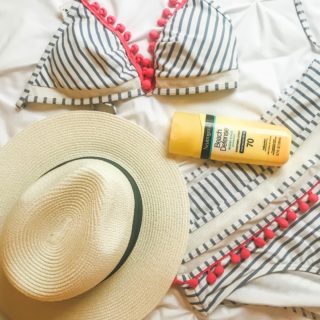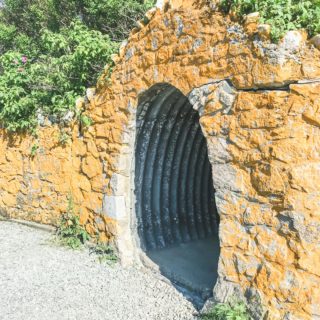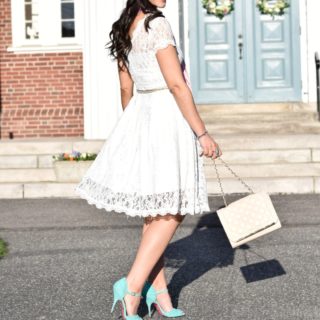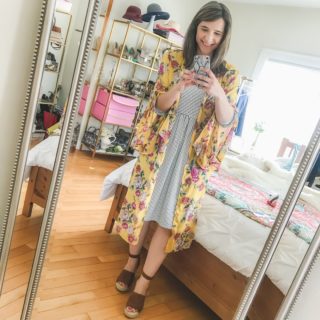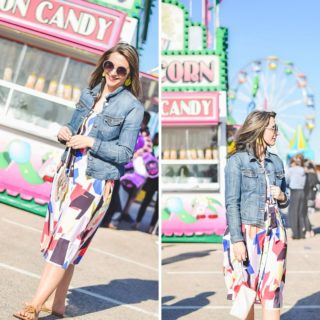Summer is almost here, school is almost out and it’s project time! I love doing paint projects in early spring and fall because you can open the windows to let out the fumes without worrying about the heat. Lucky for you, this project to paint your kitchen cabinets does not result in a lot of fumes. It would make the perfect project any time of year. Today we’re going to talk about the “easy way” to paint your kitchen cabinets.
This post is in no way sponsored. I researched and purchased this paint and these supplies with my own money. However, affiliate links are used throughout this post, which means that clicking/making a purchase through these links may result in a small commission for More to Mrs. E, which helps me keep this blog running. For more information, please see my Privacy Policy, and thank you!

This is what my kitchen looked like before painting – very dark. I didn’t mind the wood but it made the kitchen area so dark. It may not look that way in these pictures but I had to really “up” the exposure just so you could see what the kitchen looks like!

Solution? Paint the cabinets with this enamel paint (in pure white), a way that Pinterest seems to tout as the easiest way to paint your kitchen cabinets.
I’m going to start off by saying that painting kitchen cabinets is no quick little DIY project. The method itself is, indeed, easy but it is still time-consuming. And you should know, right from the beginning, that this project did not go as planned. That’s not the fault of the method itself but it does mean that I can not accurately tell you how long it would have taken to complete had I not had the setbacks I describe below.

Why this wasn’t finished quickly
Before I started this project I did tons of research, read many reviews, and weighed my options carefully before choosing a paint. In the end I chose this paint for a few important reasons.
- I could easily return it, in-store, if I bought too much.
- It doesn’t need a topcoat, so it would be easier to touch up if there were issues.
- It dries quickly and would allow me to recoat quicker.
Based on that last reason, I had it in my head that this project would only take a few days. Instead, it took me multiple months. I had to deal with a tenant eviction and repairing a rental unit of ours before I could come back and finish the kitchen cabinets. It also took longer because, even with a quick-drying paint, there are still a lot of step involved in painting kitchen cabinets. Unless you can scrub and paint all day and have room to lay out a whole kitchen-worth of cabinet doors, you’re only going to be able to do a few steps at a time.
That being said, this process was easy and much cheaper than expected. I ended up using less than half of the jars of paint I bought. When it was finished, my skeptical husband was impressed with how well it looked – and that’s saying something! So here’s what to do if you want to paint your kitchen cabinets the “easy way”.
- Clean/Degrease
- Lighly Sand
- Seal
- Paint
- Repeat for additional sides and sections.
Before You Start to Paint Your Kitchen Cabinets…
Remove all the cabinet knob and drawer pulls and put them in a bag with their screws. Even if you decide later that you won’t need them, it’s good to have some extras on hand just in case.
First, clean the cabinets
Materials: old washcloth or towel (textured to be scrubby), degreaser

I cleaned the cabinets first with THIS. It. Was. AMAZING. The cabinets themselves looked so much better after cleaning them and it didn’t take a ton of elbow grease. It took me a little over an hour to degrease the fronts of the cabinets in the evening but then you need to let it completely dry. For me this meant waiting until the next day after work.
Do not skip this step. Some of the reviews I read said that you could just wipe the cabinets down with Clorox wipes. That may be true, but if your cabinets are as old as mine, there is grime on there that should be removed. There were a few spots where I missed some accumulated grime and, after I painted, either 1) the finish was lumpy in those spots 2) the spot chipped off and then I had to retouch the paint or 3) the grime bled through the paint a little. So, don’t skip this step!
Next, lightly sand the wood
Materials: Sandpaper, Microfiber cloth
Sand the cabinets lightly all over and wipe away the dust with a microfiber cloth. In hindsight, I would encourage you to more seriously sand the areas where you might not want paint to cling. For example: very rough areas.
In most cases, my cabinets look great and I didn’t sand a whole lot. However, there are two cabinets where the rounded, curved edge is rougher and I wish I had sanded better in these spots so the paint wouldn’t cling to the rough edges.
Finally, seal the wood
Materials: Paintbrush, Stain Blocker/Sealer
While the cabinet doors were still attached, I painted the fronts of the cabinet doors with THIS sealer. This stuff went a long way. I ordered 2 jars and used about 1.25 of the jars for the entire project.
I used a brush to paint the sealer on the edges of the cabinets and the indentations. For one side of the kitchen I used a brush on the flat fronts and backs of the cabinets and on the other side I used a roller for the fronts and backs of the cabinets. I can’t say one worked better than the other. The roller definitely soaked up more sealer but I felt like the brush coated it better.

I was a little paranoid about getting every inch covered, but in the end, it was hard to tell whether it was completely covered because the sealer dried so quickly and was so transparent. This is one of the advantages to this paint system. You could clean, sand, and seal the cabinet doors before even removing them from the kitchen and your neighbor wouldn’t even notice anything was different when they stop by for coffee!
Paint your first few coats
Materials: angled paintbrush, paint tray, small paint roller. I used this one for the first few coats and this roller with this roller cover for the last few coats.
The first coats on the outer cabinet doors can also be done while the doors are still attached to the cabinets. It definitely helps the project feel like it goes quicker since the kitchen doesn’t have to be taken apart quite as long. The directions say to apply several light coats. In total, I applied 5-6 very light coats on both sides of the doors and drawers – 2 or 3 while the doors were still in place. Here are some tips for painting application.

Overall tips:
- The paint dries quickly, so only pour a little out into the pan at a time.
- If there is a streak of thicker paint, use the flat side of your brush to run it VERY LIGHTLY back over that section of paint to even it out. Since the paint dries so quickly, you want to do this as you go. Otherwise, it will dry and when you add a second layer of paint, that spot will stay darker than the rest of the areas. In my case, it often took extra layers of paint in the end before the paint would look uniform.
- When finished for the day, put your roller in a ziplock bag without washing it and store it in the fridge. No joke, I used the same roller and roller cover for almost all of this project and it stayed in the fridge for almost 2 months. This made it easy to pull out and do a layer of paint even on my lunch break.
The Fronts of the Cabinet Doors & Drawyers
Because the paint dries so quickly, it’s a good idea on the first coat to paint one entire door at a time so get both your brush and your roller ready. You will see in these pictures that I did not do what I’m telling you to do here. On my first few coats I painted the interior beveled edges on all the doors, then all the outside beveled edges, etc. However, I discovered that when I painted all the inside edges first with my brush, I would get some paint slipping over onto the raised flat front. (see picture below)

If I went on to another door and did this to a series of doors, the paint would dry by the time I came back to paint the raised, flat front. If I rollered over the splotches when it was already dry, it would make those spots darker than the rest of the cabinets and require additional coats overall. So instead I recommend:
Working one door at a time…
- Paint the interior bevel of the door.
I did this with an angled paintbrush (I LOVED this one), and make sure to get into the corners. I also painted up under the edge and into the corners of the flat interior section that touched the beveled interior. (see this in the image above)
- While the paint is still wet, roller the flat section inside the interior bevel.
By painting these two sections one right after another, I can fade any overlap into the other section’s wet paint. For example, in the image above there is overlap of wet paint onto the flat interior. But, this is ok because when I run the roller over that section in the very next step, the paint is evened out.
- Paint the exterior beveled edges with your angled brush.
**Be careful not to let the paint build up in any one spot. This will only make it more difficult when you go to add additional coats. If you can’t get to all of the outside edges with the cabinet doors still attached, that’s ok. You can skip painting those outer edges and just roller the front.
- Roller the raised flat section between the two bevels.
If you skipped painting the outside edges, make sure to use your brush to smooth out any paint from rollering the flat front that does get onto the outside edges. Or, wipe it off with a damp paper towel.
Let the paint dry (30 mins to an hour usually) and then paint a few more coats, with the same method, while the doors are still attached. You will remove them for the back and the final coats. Because of the quick drying time, you can complete a few coats in one day if you have enough time and space to spread out all the pieces that need painting and drying.
I used this same method to paint the fronts of the drawers, though it went much quicker since there were fewer beveled edges.
Materials Used: I painted three coats on the fronts of all the cabinet doors and drawers (top and bottom) before removing them and only used 1.5 jars of paint, which was much less than I expected!
The backs of the cabinet doors and the cabinets themselves
Removing the Cabinet Doors and Drawers & Prepping for Paint
You will need: Drill, Bag or container for screws and hinges, degreaser, rag
Once the fronts of any doors or drawers are painted and dry, remove them. Unscrew the cabinet doors from the cabinets and remove the hinges from those doors. *Cabinet door removal is easier with two people.* Place all the hinges and screws in a bag so you do not lose them.
Lay the doors out on a flat surface (a garage would work great. I used my dining table covered in a paint barrier). Degrease the backs of the doors using the same materials as described above. Let dry. Then, seal the backs of the doors as described above.

Painting the Backs of the Cabinet Doors
Once dry, paint the backs of the cabinet doors as you did the fronts. The only difference is that there will be no beveled edges and more flat sections.
Pay special attention to the outside edge of the doors where the front and back meet. Make sure you get these well with your brush or roller to make sure that there is no gap in the paint. Roller the flat back touching this area right away to make sure to fade the paint into the back section.

Repeat the process for a few coats on the backs of the doors. Then, when dry, flip the doors over and add a few more coats to the front.
This is the time to really get the outside beveled edge well if you were unable to do so while the doors were attached. However, be careful. As you can see above, some paint from the outside edge may leak onto the back side of the door. If you have already painted a few coats on the back, this will be less noticeable. However, it may be a good idea to very carefully lift the cabinet door up to check the back after you have painted a coat on front outside beveled edge. Either fade the overlapped paint into the paint on the back or wipe it off with a damp cloth.
Add as many coats to both sides of the doors as it takes for the finish to appear smooth and opaque.
A NOTE ON STAGGERING: If you work on this a little at a time, you can stagger the degreasing, painting and drying. For example, I degreased the backs of half the cabinet doors and let them dry one evening and while they were drying, degreased the kitchen cabinets. The next morning I painted the first coat on the backs of the cabinet doors that I had degreased the night before. While the paint was drying, I started taping the kitchen and painted the interior edges of the cabinets (described below). The drying time is not long for any of the pieces so it works well to stagger this part of the process.
Paint the Kitchen Cabinets Themselves
First, make sure the cabinets themselves are degreased and sealed as described above. I did half the kitchen cabinets at a time. When the first half was dry, I lightly sanded and painted a coat of sealer on the cabinets themselves and moved on to degrease the second half of the kitchen.
By the time I had degreased the second half of the kitchen, the sealer was dry on the first half. I taped the inside edges of the cabinets and then painted the interior edges.

By turning the tape so that the sticky side is flat against the back of the edge of the cabinet (see pictures), you make it easier to paint the inside edge. You don’t need to paint it perfectly because you can just tear away the tape to make a smooth edge. It also gave me extra roller clearance so that the things in my cupboard were less likely to get paint on them.

Moving between the two sides of the kitchen, I sealed, sanded, taped, painted interior edges and then taped and painted the trim at the top of the cabinet.
The general order was: Degrease, Lightly Sand, Tape, Seal, paint interior edges (1), paint trim on top of cabinet (2), roller everything flat (3). and repeat with more coats.

Replacing the Hardware
Hinges
While you’re going through the process to paint your kitchen cabinets, it’s good to think about what hardware you will use when you put the cabinet doors back on. New hinges can make your newly painted doors that much newer. This is a good time to comparison shop to find the right hinges.
If you can’t find replacement hinges (I couldn’t) just like the ones you took off your doors, and you don’t want to take the time to redrill all your doors for new hinges, then you can simply paint your hinges. That’s what I did but I will save that process for a stand-alone post.
Knobs/Pulls
Another piece of hardware to consider is your knob. If you plan to change the style of hardware on the cabinet door fronts, decide that before you apply the first coat of paint. You will have to fill in the holes from the previous hardware before painting. We decided to just switch out the old knobs for new ones that would fit in the same holes. We chose THESE and they made a world of difference.
Wrapping up the project
Once you have coated all the doors and cabinets, remove all the tape from the cabinets. Check to see if there are any spots that need touching up before reinstalling the doors. I applied an extra coat or two of paint to the areas I knew would get extra wear and tear.
Finally, it’s time to reinstall the doors. Using the bag of hinges and screws you saved when you took down the cabinets, screw the hinges back onto the doors with your drill. Then, screw the doors back onto the cabinets.

With the doors back on the cabinets, check for any thinner areas of paint that are now coming to light in a different setting. I ended up rolling on an additional coat of paint to the fronts of two cabinet doors. Once dry, screw the knobs back onto the cabinets and drawers.
Stand back and admire your hard work! Here is the final look!

Overall, I am very happy with this method to paint your kitchen cabinets. Not only do my cabinets look beautiful, but it took WAY less paint than expected. I used less than half the paint I ordered. Unfortunately for me, it was past the return date for the paint since this project took so long.
Having extra paint with this method is a good thing though. Because there is no topcoat, I can simply use the extra paint for touch-ups. I scratched one of the doors when reinstalling and was able to just use some touch-up paint to get that spot. You can’t even tell.
Here are more before/after photos:

Overall, I think Pinterest is right. This is a very easy way to paint your kitchen cabinets. It’s cheap, looks beautiful (if you do it properly!), and requires no special skills. However, it is still time-consuming. If you have the time and the inclination, I think this would be a great way to update your kitchen cabinets on a budget!
I’m sure you have questions. I know I did when I was researching all the different methods! Please leave any questions below in the comments for me to answer and stay tuned for a follow-up post on how to paint your hinges!
Thanks so much friends! Please make sure to pin for later!
-Virginia

Linking up with: Your Whims Wednesday | Inspire Me Monday | Artsy-Fartsy Link Party | Pretty Pintastic Party | Friday at the Fire Station


















